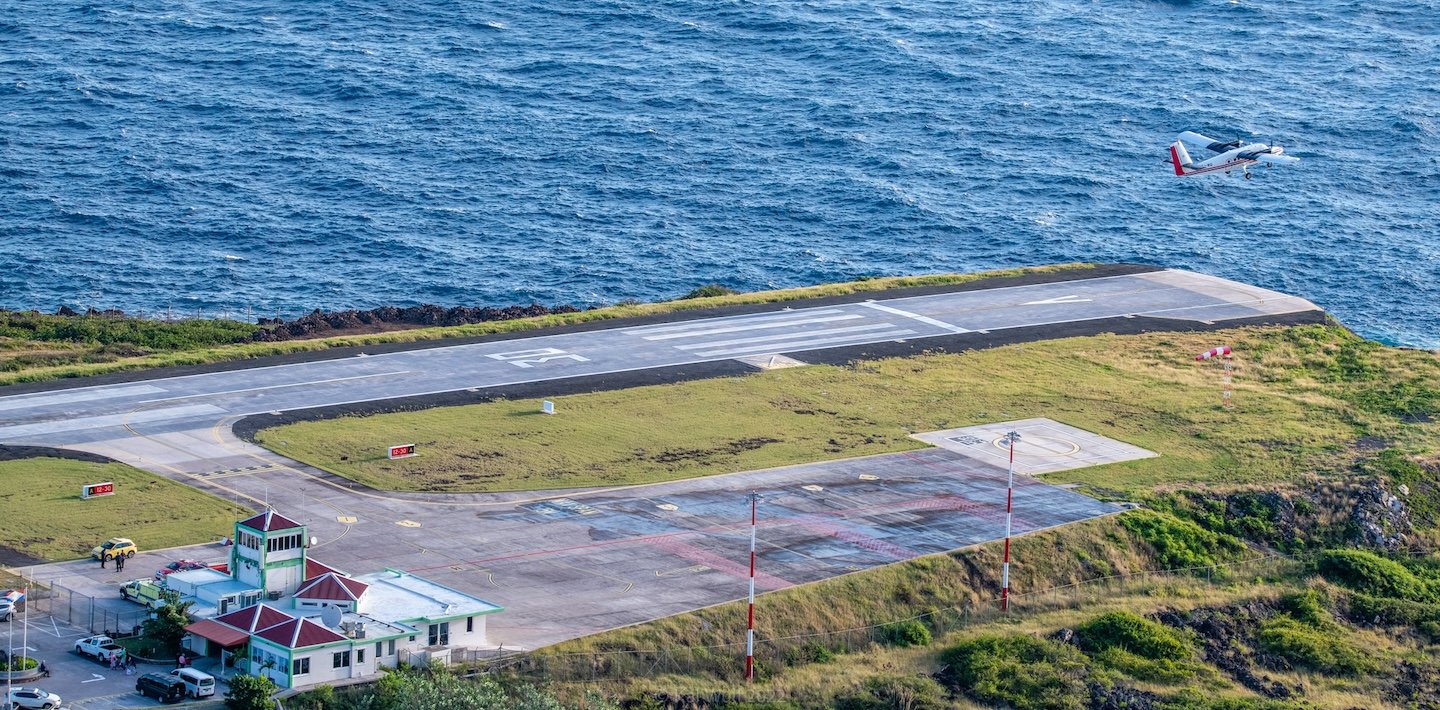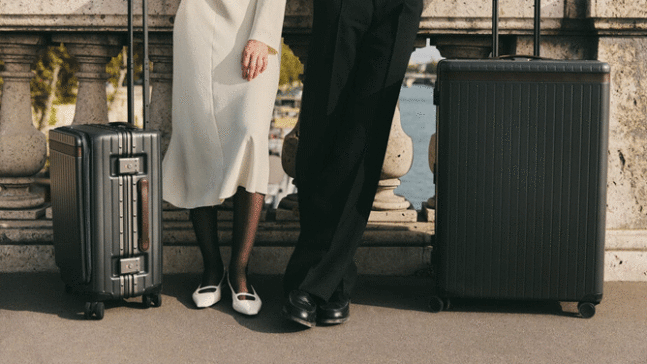When you have an opportunity to fly into one of the world’s least visited islands into the world’s shortest commercial runway, why would you take a ferry instead?
That was my response when people asked why I was flying into Saba from Princess Juliana International Airport (SXM) to Juancho E. Irausquin Airport in Saba (SAB), instead of taking the 90-minute ferry. Despite being ecstatic to finally visit Saba, a five-square mile Dutch island in the Caribbean, the flight was inarguably one of the things I was most looking forward to. Home to the world’s shortest commercial runway, only 1,312 feet compared to the commercial average of 8,000 to 13,000 feet, I was sure the journey into Saba would end up becoming one of the most exciting parts of my trip to the intriguing island.
After a short jaunt from JFK, I arrived in Saint Martin. I was meeting friends who I’d continue onward with to Saba, and after going through immigration and customs, I met up with them at baggage claim. We noticed none of us had seat numbers on our flight tickets from Saint Martin to Saba, so we collectively agreed to go to the WinAir desk to all request a window seat for the short but allegedly scenic flight. When we got to the WinAir desk, however, we were told there are no assigned seats and that everything was a first come, first serve. To add insult to injury, the flight only held 12 passengers, and was completely sold out. This news fueled my slightly unhealthy competitive spirit. The Saba flight became an extreme sport in my brain. It was an opportunity too rare to not get the best damn seat on the plane.
The best seat on the plane is a front row window seat, and after picking the brains of a few WinAir staff members at SXM, I was informed that for flights flying into the island, that meant on the right side of the plane. With no time to waste, despite our flight not leaving for close to two hours, I booked it to the gate. I firmly planted my feet as close to the desk as possible to claim my territory. People approached, “Is this line for the flight to St. Barth?” and before I could bark, “No, it’s to Saba!” (pronounced like Sega with a B), a WinAir employee said, “Yes.” Turns out, at the designated Saba gate, because flights are so small, short, and infrequent, there are often flights to other nearby hard-to-reach islands scheduled closely within similar timeframes. The St. Barth flight was leaving only about thirty minutes before our Saba flight, meaning I had to forgo my number one position as being the first person on the plane to let St. Barth passengers line up ahead of me.
It was an opportunity too rare to not get the best damn seat on the plane.
Putting my pride aside, I lost my firm footplant, and took the seat to allow room for St. Barth passengers to line up.
St. Barth boarded and took off, and Saba passengers were called to line up. My seat, which was the second from the desk, was ideal for ensuring I was first in line yet again, but I was in for another pivot.
Instead of boarding the flight, all 12 of us were piled into a van to drive us closer to the plane. Logic has it that the person sitting closest to the door is usually the first person to get out of a car, so I nudged my way to take a seat closest to the van’s door, while my friends had a good chuckle at how adamant I had been in the airport only to be starting back from step zero, simply from having to get in a car.
We got dropped off at the plane, which was a de Havilland Canada DHC-6 Twin Otter. Having deja vu, I once again, bee-lined to be the first one on the plane. And guess what?
I did it.
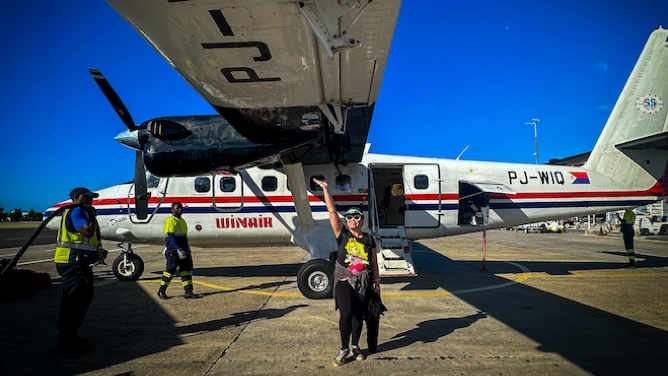
Credit: Kaitlyn Rosati
I was the first one on the plane, and I got that prime, coveted front row right window seat. We were all handed fans because the flight wouldn’t have A/C for the short journey.
Before we knew it, the propellers were riling up, and we were off. The flight doesn’t reach more than about 3,000 feet, and taking in those eggshell-white sands of Saint Martin as they fade into the cobalt blues of the Caribbean felt like looking under a microscope from the sky.
As the plane began to descend, I saw a tiny jarring mountain in the distance. “It’s Saba!” we all collectively screamed.
There were two pilots on the flight who witnessed not only mine, but also my group’s excitement, and as I was shamelessly filming close into the cockpit, the one directly in front of me grabbed my phone, and snapped a shot for me, winking at the excitement of it all. Something told me, we weren’t the first people to be giddy over this experience.
Speaking of the pilots, don’t stress about who’s flying you on this unique route. Pilots need to complete this journey three times every 30 days in order to be qualified to fly this particular route; otherwise, they must be retrained.
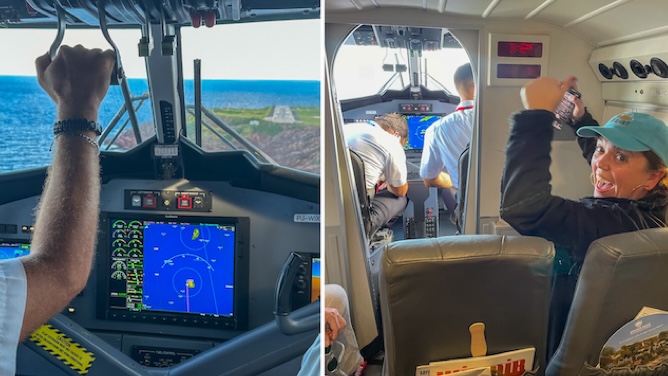
Credit: Kaitlyn Rosati
Despite being an avid flier, landing was something I latched onto both armrests for. I imagined a bumpy, slam-on-the-brakes, sudden-halt type of experience, but it was surprisingly smooth, considering the circumstances. There’s a quick U-Turn at the end of the very short runway, which seems to slow down the plane’s natural momentum.
Flight aside, Saba is worth the trip. Saba Spice, the island’s local spirit, is sipped in flavors like ginger and orange, the island is home to the highest point in the Kingdom of the Netherlands at Mount Scenery. It’s also a scuba diver’s paradise. Safe to say, Saba is one of the few places in the world where the journey is equally worth the destination, especially if you fly in.
Lead image credit: Kai Wulf / Saba Tourism
More Travel
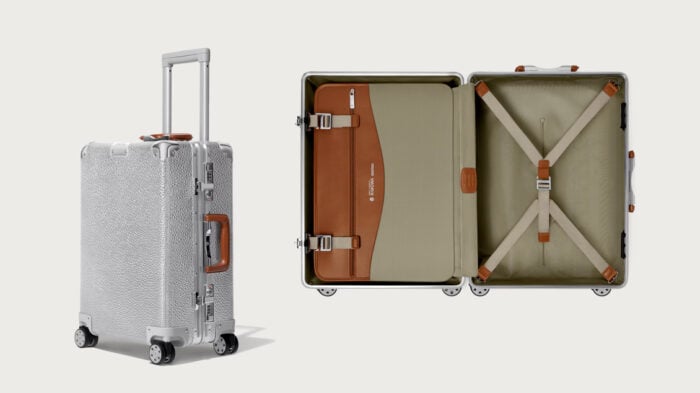
Rimowa Debuts Hammerschlag Luggage Collection
The Hammerschlag Luggage Collection from Rimowa is a new direction for the beloved suitcase makers.


Destination Birding: 8 of the Best Places, Festivals, and Ways to Get Into the Hobby
It's safe to say there's never been a better time to get into birding. Writer and bird watcher Brandon Withrow on the can't-miss events for those deeply engaged in the hobby and newcomers alike.

